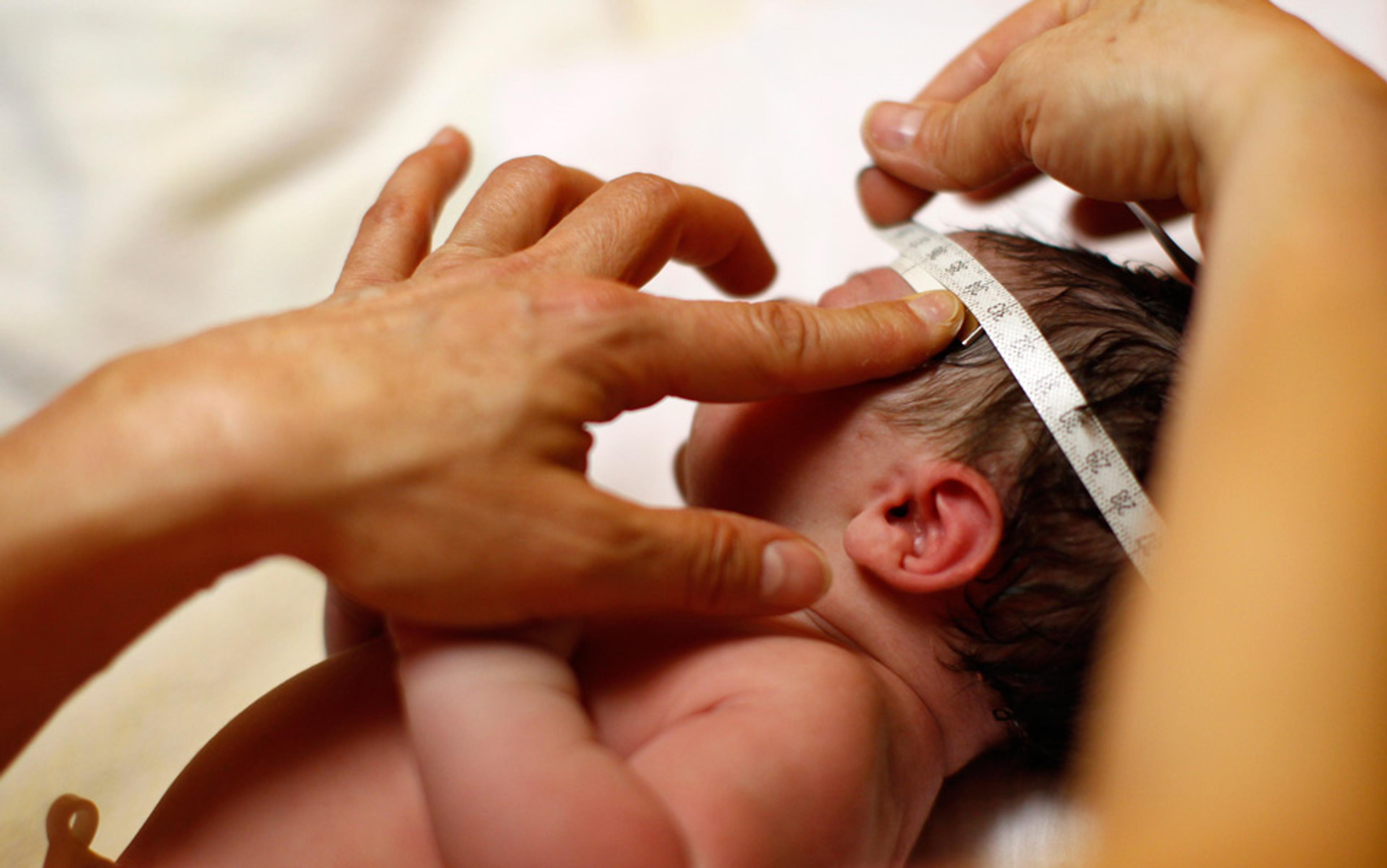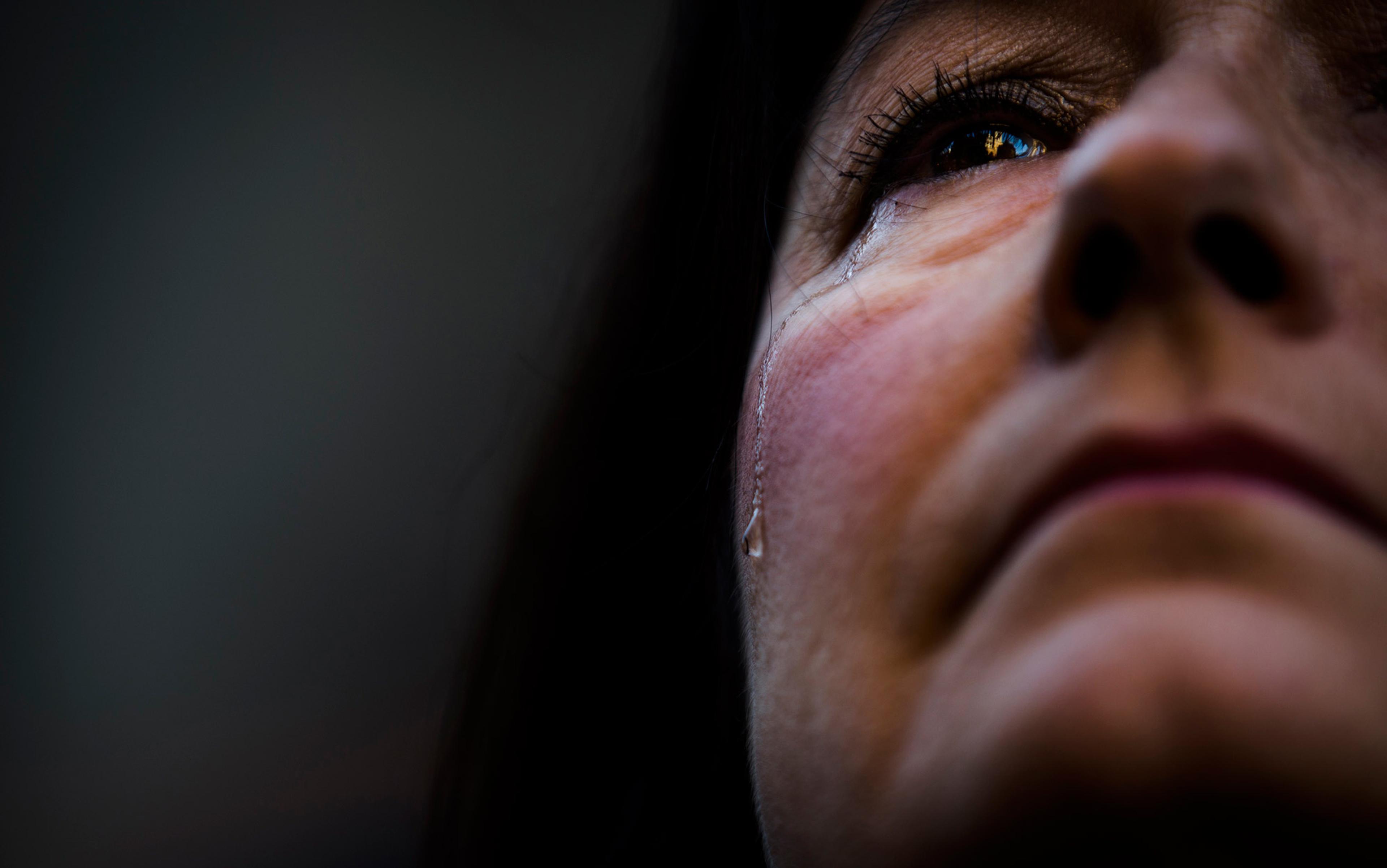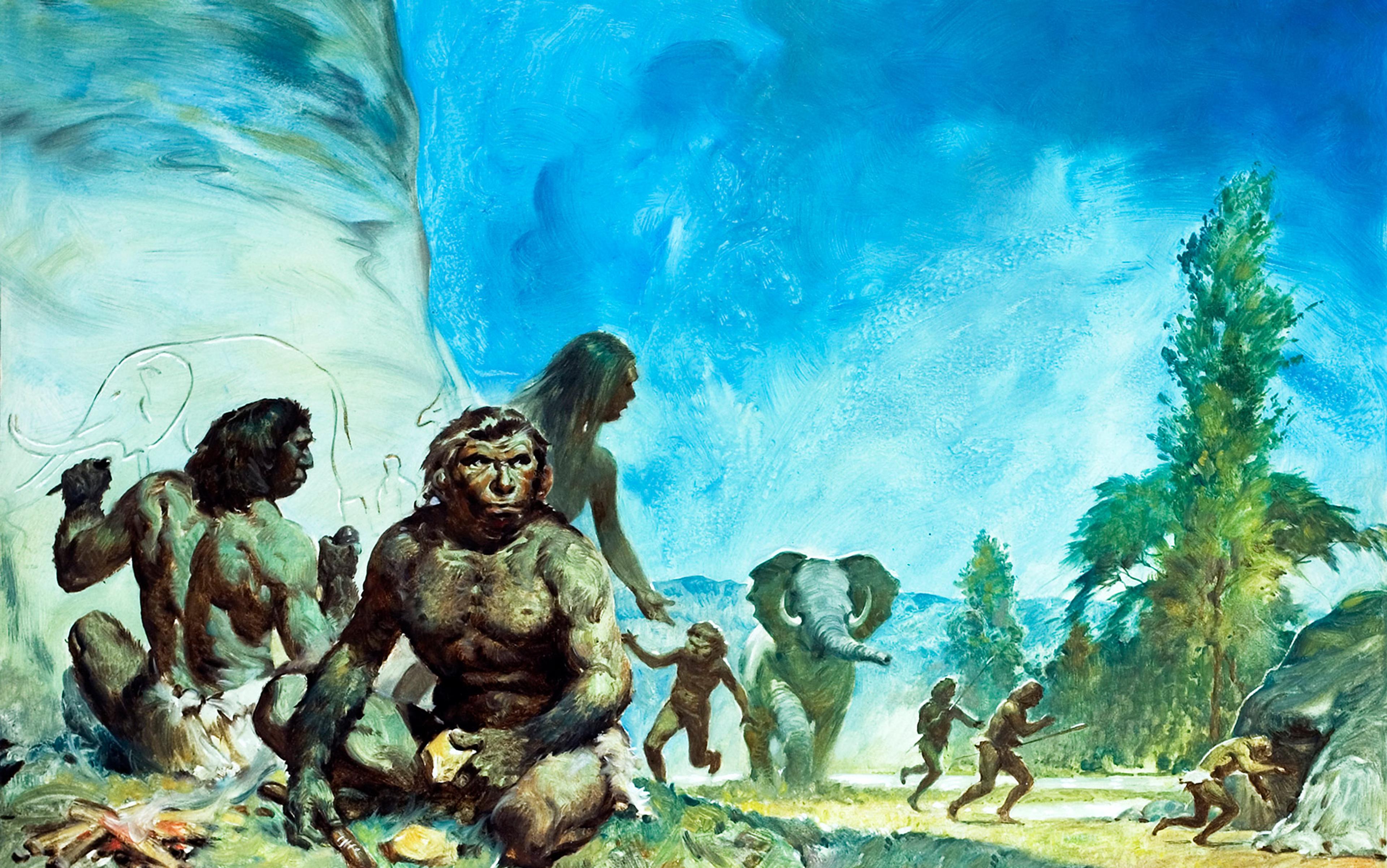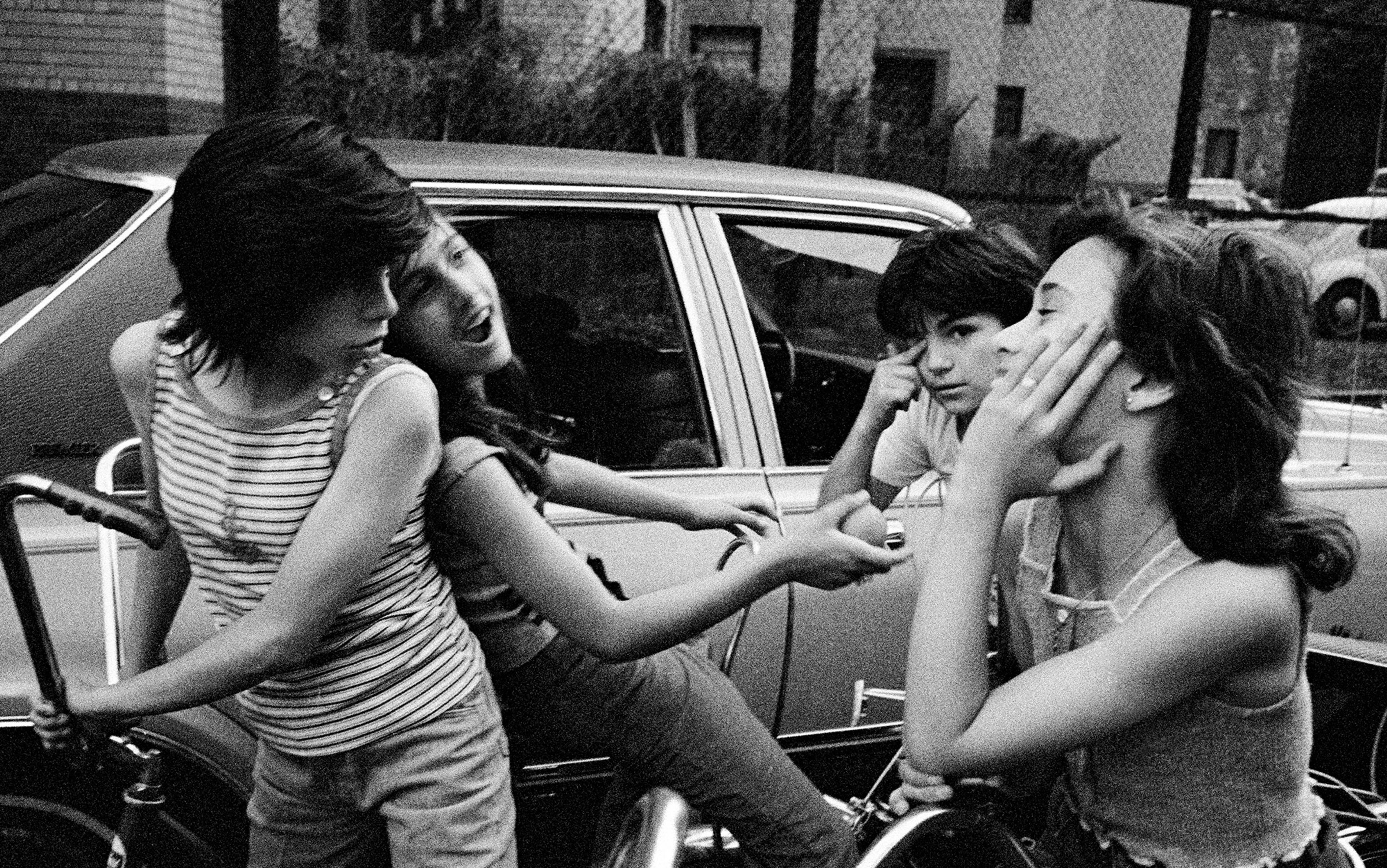‘If he grabs you, just go limp and let him throw you around. If you tense up, he’ll take it as a dominance challenge.’
‘Um. Okay.’
My brothers and I looked at each other. This was last-minute advice. We were clinging at a 45-degree angle to the Mount Bisoke volcano, having hacked and crawled for three hours through stinging nettles. We started out in Rwanda; now we were in the Congo. Of course we weren’t supposed to be there, but mountain gorillas don’t respect national borders. With our machete-wielding guides, we had found the gorilla group called ‘Amahoro’, Kinyarwanda for ‘peace’. I just hoped they were in a peaceful mood today.
Before coming to Africa, I had just finished writing a review of America’s two new mother-ship museum exhibits: the Koch Hall of Human Origins at the Smithsonian in Washington DC, and the Spitzer Hall of Human Origins at the American Museum of Natural History in New York. Like every other presentation of our prehistory, these otherwise excellent exhibits focused on the evolution of our big neo-cortical brains — the adaptive significance of tool use, linguistic ability, increasing cultural sophistication. I guess it seems natural to celebrate the development of our unique cognitive abilities, since these distinguish us from our mammal relations.
Out in the bush, however, I began to appreciate how biased this cognitive picture really is. We owe a debt to our big neo-cortices, but our survival owes much more to the emotional skills that were under construction in mammals long before the Homo sapiens cortex explosion. We share a rich emotional life with our animal brethren because emotions helped us all survive in a hostile world. Indeed, the more we understand what mammals have in common, the more we have to rethink everything about even our specifically human intelligence.
On the side of the volcano, my brothers and I caught our breaths. ‘Okay,’ said our guide with a smile. ‘Let’s go see our cousins.’
Outside my tent in the Serengeti, a week before our gorilla trek, I looked up at the Milky Way. It was clearly visible — downright sublime — unlike the starless Chicago sky back home. It is the same awe-inspiring canopy that our ancestors, Homo sapiens, peered up at 200,000 years ago. My brothers and I were camping in the cradle of hominin evolution. Hyenas laughed in the distance.
For days we had been riffing on Stanley Kubrick’s film 2001: A Space Odyssey, which putatively takes place somewhere in this Rift Valley. I kept picturing a mysterious alien monolith in the distance and singing bad versions of the film’s opening fanfare, Thus Spake Zarathustra by Richard Strauss. My brothers countered with a barrage of sci-fi references such as The Land Before Time, Quest for Fire, 10,000 BC, and the classic hominid regression of William Hurt in Altered States. In our own puerile way, we were trying to process the emotional climate of our primordial landscape.
The fear is palpable. That part is not abstract or philosophical — it permeates almost every moment on the Serengeti. If I get out of the truck, these lions will eat me. If I try to cross this little river, the crocs will shred me in minutes. Even the comic, bulbous-bodied hippo is menacing in person. They kill more humans than any other animal in Africa. I watched a hippo fight explode in front of us, and it seemed to shake the ground itself.
One thing you gradually begin to understand in this ancestral environment is the inevitability of death. The carnage is so predictable that a good tracker can judge the trajectories of prey and predators, and then park the safari truck in a prime spot to watch. This is no scam. Crocs have to eat. Wildebeest have to drink. Add those facts together and bloody spectacle inexorably follows.
‘He was a breakfast for crocs this morning, but now he is a walking dinner for hyenas tonight’
One morning we broke camp early, climbed into our safari truck and raced off-road through the scrub to a rapidly shrinking creek. Our tracker Mohammed had received a walkie-talkie tip from another tracker that a herd of wildebeest was preparing to cross. Mohammed knew that crocs would be sunning themselves nearby, and that drama might ensue. For a guy who had been tracking these animals for the past 15 years, he seemed as excited as we were. Parked on a riverbank, we watched in silence as wildebeest sniffed at the water’s edge. They moaned and paced anxiously while reptile eyes began to multiply above the water line.
Wildebeest, it turns out, are really dumb. Mohammed explained that if zebras start to cross a waterway and lose just one of their number, they usually cancel the mission, back up the herd and look for alternative passage. Wildebeest, by contrast, will continue to throw themselves into the croc-filled water. Once they’ve committed to crossing, through some tipping-point of group emotion, they seem incapable of modifying or adapting to the new situation. Panic sets in and the wildebeest leap into the fray, snapping their own legs, breaking their backs, drowning each other.
As we were watching, a woman in our party began to scream. She’d seen a lone wildebeest venture too far — only a metre off the shallows — and then a croc leapt up. The herd started to run; pandemonium ensued. Only when the other animals had disappeared into the distance did the crying of the luckless victim go quiet. In preternatural silence, it pulled itself toward the shore, revealing a giant crocodile fastened onto its hindquarters. A back leg was already down the reptile’s throat, the rump locked by razor-sharp front teeth.
‘This is now a waiting contest,’ Mohammed explained. ‘The croc will never let go.’ The wildebeest was stronger than I expected, but it couldn’t overcome the croc. Other crocodiles were starting to make their way toward it. Then something surprising happened, something that shocked even the seasoned Mohammed. After about five minutes, the predator tried to adjust its grip. In that fraction of a second, the straining wildebeest shot free and found itself — as startled as any of us — teetering on the shoreline. The woman who had first spotted it cried out in relief. We all felt an exhilarating rush of triumph for the underdog. A happy ending.
Mohammed took the wind out of our sails. ‘He was a breakfast for crocs this morning, but now he is a walking dinner for hyenas tonight.’ True enough, the wildebeest’s leg was now a mangled ribbon hanging loosely off its hindquarters. An easy target. Our city-slicker buoyancy was premature. Nature is not merciful.
Time on the Serengeti makes you think a lot about the inner life of animals. While the wildebeest is screaming, is it feeling fear like we do? Is it relieved when it’s suddenly free? Is the croc filled with regret? It might seem self-evident to the sentimental pet owner that our fellow creatures have emotions, but science has long been loath to admit it. Yet Jaak Panksepp, professor of veterinary anatomy at Washington State University College, says this is one area where our anthropomorphic tendencies are probably in the right: animals do have complex emotional lives.
Panksepp is the founder of the new field of affective neuroscience. What makes his work especially compelling is that he has learned how to turn the major emotional systems on and off in his animal subjects. The squeamish won’t like some of his experiments — they include removing brain parts of living rodents and sewing two rats together — but the data are important. Using electrical stimulation, he has demonstrated that mammals have emotional/behavioral responses built into the subcortical and limbic parts of the brain.
After you spend time with wild animals in the primal ecosystem where our big brains first grew, you have to chuckle at the reigning view of the mind as a computer
Panksepp stuck an electrode into the medial hypothalamus of a cat. At first, the animal was perfectly peaceful. When Panksepp administered an electrical charge, it leaped viciously at his head, a hissing spitting tangle of fangs and claws. As soon as he turned off the stimulation, the cat relaxed into a peaceful state and could be petted with no sign of danger. Humans who have had electrical stimulation in the corresponding brain locations also reported intense rage, which lends credence to the idea of animal subjectivity.
Old-school behaviorists, resistant to the idea of animal emotions, might describe what the cat underwent as ‘sham rage’, but Panksepp is biting the bullet and calling it what it looks like — rage. And ethologists who study animal behaviour increasingly accept the idea that fear keeps animals away from predators, lust draws them toward each other, panic motivates their social solidarity and care glues their parent-offspring bonds. Just like us, they have an inner life because it helps them navigate their outer life.
We came upon a huge male lion in his mating ritual with a female. With stealthy off-road driving, we crept within a few metres of their love nest — sex nest, actually. They had detached themselves from the larger pride and were engaging in the standard three-day romp. When the female is in oestrus, or on heat, the male will spend the first day mounting her every 10 minutes, like clockwork. On the second day, they mate every 15 minutes, and on the third day, every 30 minutes. In between these quick sex sessions, the two laze about sleeping in the high grass. The male mounts the female from behind and engages in light neck-biting until he achieves a micro-roar petite mort. None of this is cute or cuddly or tender. In fact, in many cases, the male lion has put the female on oestrus by killing her cubs. Killing the babies of a previous romance will stop the lactating of the mother and put her back in oestrus, so the new male can replace the previous gene line with his own.
Lions, our guide informed us, do not have sex for pleasure. Other animals do, but lion sex, at least from my perspective in the safari truck, looked perfunctory, utilitarian and grudgingly purposeful. It is sex at its adaptational no-frills finest: chemically triggered, involuntarily acted, immediately forgotten. Violence on the Serengeti worked the same deterministic way. Predators would be in rest mode or play mode until a trigger (a smell, a movement) switched them into hunt mode. It was the same with the herd animals: their default settings are set to twitchy nervousness all the time, but they can switch up to group panic at the slightest signal.
This is not to say that the actions of the animals are deterministic like a machine. That’s an old prejudice, from Descartes’s bête machine to Pavlov’s dog. No, animals in the wild are definitely not machines, but they are deterministic in the sense that they are relatively unthinking. Many animal behaviors that look like the result of reasoning, aren’t. I asked how the parent lions know which cubs are theirs, an identification that seemed pretty smart to me. Mohammed explained the Jacobson organ.
This vomeronasal organ (named after Ludwig Levin Jacobson, who discovered it in 1811), is a chemoreceptor found at the roof of the mouth in many mammals and some snakes. Pheromones and other chemicals enter into the mouth, are taken up by the Jacobson organ, and sent to neural targets in the amygdala and hypothalamus. Sometimes you’ll see your pet cat doing an open-mouthed grimace — he’s using his Jacobson to assess a new situation. When lions clean their own cubs just after birth, chemicals pass from the babies through the parents’ Jacobson organ to the adult brain. A chemical fingerprint is recorded, and the identification is set as a permanent record. Whenever the cub’s chemical stimulates the parent’s brain, it fits like a key in a lock. In this way, male lions do not accidentally kill their own cubs, and mothers ‘know’ which cubs to nurture. It’s a clever system, but it is not a case of rational inference in lions.
Infanticide is not some aberrant behavior among mammals. Horrifying as it might seem, it is an entrenched part of reproductive strategy. Some biologists believe that it is a default behavior that gets repressed or gated by a specific chemical signal. The brain hormone oxytocin promotes nurturing behavior in mammals; females generally have more of it than males. When males have sex, however, oxytocin floods their systems and mellows them into kinder, gentler versions of themselves. In many mammals (especially rodents), the male oxytocin peak synchronises with the birth of their own pups. The mellowing effect of sex actually ensures that aggressive males won’t kill their own pups. There might be a chemical truth to the old advice, ‘Make love, not war.’
After you spend time with wild animals in the primal ecosystem where our big brains first grew, you have to chuckle a bit at the reigning view of the mind as a computer. Most cognitive scientists, from the logician Alan Turing to the psychologist James Lloyd McClelland, have been narrowly focused on linguistic thought, ignoring the whole embodied organism. They see the mind as a Boolean algebra binary system of 1 or 0, ‘on’ or ‘off’. This has been methodologically useful, and certainly productive for the artifical intelligence we use in our digital technology, but it merely mimics the biological mind. Computer ‘intelligence’ might be impressive, but it is an impersonation of biological intelligence. The ‘wet’ biological mind is embodied in the squishy, organic machinery of our emotional systems — where action-patterns are triggered when chemical cascades cross volumetric tipping points.
Neuroscience has begun to correct the computational model by showing how our rational, linguistic mind depends on the ancient limbic brain, where emotions hold sway and social skills dominate. In fact, the cognitive mind works only when emotions preferentially tilt our deliberations. The neuroscientist Antonio Damasio worked with patients who had damage in the communication system between the cognitive and emotional brain. The subjects could compute all the informational aspects of a decision in detail, but they couldn’t actually commit to anything. Without clear limbic values (that is, feelings), Damasio’s patients couldn’t decide their own social calendars, prioritise jobs at work, or even make decisions in their own best interest. Our rational mind is truly embodied, and without this emotional embodiment we have no preferences. In order for our minds to go beyond syntax to semantics, we need feelings. And our ancestral minds were rich in feelings before they were adept in computations.
Our neo-cortex mushroomed to its current size less than one million years ago. That’s a very recent development when we remember that the human clade or group broke off from the great apes in Africa 7 million years ago. That future-looking, tool-wielding, symbol-juggling cortex grew on top of the limbic system. Older still is the reptile brain — the storehouse of innate motivational instincts such as pain-avoidance, exploration, hunger, lust, aggression and so on. Walking around (very carefully) on the Serengeti is like visiting the nursery of our own mind.
Another death-knell for old-school evolutionary psych might be sounding from the field of hominin-era climate studies
In those early days, our lives were dominated by the limbic region. It’s the same system that most mammals share: an integrated memory and emotion processor, composed of the hippocampus, amygdala, anterior cingulate, and so on. These social brains are somewhat plastic and open to experience, but they’re also wired, according to Jaak Panksepp’s research, for parent-child bonding, panic, rage, anxiety, loneliness, and play. As Panksepp explains in Affective Neuroscience (2004), these limbic systems ‘allow newborn animals to begin responding coherently to the environments in which they find themselves’. The brain that ‘feels’ precedes the brain that ‘thinks’.
What’s more, the process by which we attach fear, anger, and desire to the right kinds of creatures in our environments turns out to be quite flexible. Humans are afraid of the dark, but rats — our more distant mammal kin — are afraid of the light. It’s the same emotional system, assigned to different settings thanks to neuroplasticity.
This flexibility is changing the game in contemporary theories of mind. Until recently, evolutionary psychologists such as John Tooby, Leda Cosmides and Stephen Pinker characterised the mind as a series of independent problem-solving modules, like separate gears in a watch. Each of these modules, they argued, was sculpted by natural selection during the Pliestocene to solve a specific survival challenge; we now inherit them in toto as part of our genetic birthright. Perhaps the most famous such module is Noam Chomsky’s ‘deep grammar’. Chomsky argued that language is too difficult to pick up from scratch using only our general intelligence, so we must be born with a genetically engraved, brain-based program that just does one thing, namely, acquire and employ language. The module has to be activated by specific, cultural languages, but the deep grammar is innate.
Evolutionary psychologists have tried to apply Chomsky’s module idea to almost every other mental activity. What kind of food we like, what kind of spouse we’re looking for, our phobias of snakes and spiders, our preference for certain kinds of stories, even our ability to detect cheaters in a group: all have been attributed to specialised programs in the brain. This neat, formulaic explanation of human psychology plays well in the popular press, but it seems less convincing as we learn more about brain development and early human ecology.
Its chief rival is the school of ‘general intelligence’. According to this view, the neocortex is a highly flexible, general problem solver. Our environment selected for a mind with reliable pattern recognition and prediction powers, but it didn’t give us specific modules for thought contents or behaviors. As affective neuroscience advances, this scenario comes to look more credible, albeit with a surprising twist. It seems that even the emotional springs of the limbic system — our fear, care, rage and so forth — are more pliable and open-ended than we previously thought. If even instinctive emotions can be trained and rewired, how much more plasticity must the neocortical mind possess? Affective systems as understood by Panksepp are not dedicated to one or two behaviors: they serve as general emotional problem solvers with many adaptive functions.
Another death-knell for old-school evolutionary psych might be sounding from the field of hominin-era climate studies. A vital premise for the modular theory is that our minds evolved in an extremely stable, unchanging environment. If our current minds are a mishmash of Pleistocene adaptations, then the conditions that shaped our brains must have been very consistent, or else natural selection couldn’t sculpt each module to fit our perennial environmental challenges. But it now appears (thanks to the work of paleoanthropologists such as Rick Potts) that the environment was anything but stable during the brain boom. In fact, it was precisely the climate chaos of this era that created our multipurpose, problem-solving minds. If the weather, and therefore the context in which we did our foraging and hunting, kept changing radically, hardwired specialised modules aren’t going to do us much good. What we needed was all-purpose intelligence that could perceive new challenges and apply general logical rules and cultural folkways to solving them. Remains of ancient hominins, especially Homo, are found in very diverse habitats in highly fluctuating climates. The expansion of the brain corresponds with an increasingly flexible, adaptable, mind.
If human conceptual thought was largely generated by the evolution of language, then we can estimate the birth date of our cognitive skills. But it’s a big window — somewhere between 200,000 and 30,000 years ago. Some time after the origin of anatomically modern humans 200 millennia ago, the FOXP2 gene mutated and set the stage for language evolution (recent Neanderthal DNA analysis might push this mutation date back slightly). That means our rich cognitive life didn’t emerge until after the extinction of Homo erectus. Compare those 200,000 years of language-based cognitive life with approximately 200 million years (the late Triassic) of emotional life. Some 200 million years ago is when mammals first began to emerge, and this is when the rudimentary emotional systems of lust, aggression, seeking, care, panic and so on began their rise to dominance.
Did emotions really begin to appear with the birth of mammals? Presumably dinosaurs would have had fear and aggression; these useful affects might be distributed throughout the vertebrate clade. But did they ‘care’ about their young, like mammals do? Did they bond? No one really knows for sure. Scientists try to solve some of these deep-time questions by looking at contemporary reptile brains and behaviors. Most reptiles don’t require parenting: just overproduce your eggs, fertilise, and walk away. Reptiles never evolved care because they didn’t need it. But they did need ‘fight or flight’ and of course they have it: it’s located in the lower, older part of the brain, unlike mammalian care, which is in the higher limbic.
The fact that some dinosaurs nested, however, suggests that they might have been more like contemporary birds. Perhaps they had some pre-mammalian, affective chemistry system. Alternatively, they might have had hardwired behavioral instincts that only mimic our own parental systems. Dinosaur parenting and mammal parenting might be convergent behaviors, without having to ‘feel’ the same in any intelligible sense. Unlike most other non-mammal vertebrates, birds have remarkably ‘mammal-like’ parental behaviors, so evolution is filled with contingent and convergent pathways of adaptive behavior. We are only just beginning to crack open the emotional interior of these paths.
When you’re with near relations, however, ordinary empathy may be all you need to know how they feel. While my brothers and I watched the mountain gorillas of Rwanda, we witnessed doting mothers nestling, suckling, and carrying their tiny infants. We had to be extra-careful to avoid any threatening movements toward the mothers, and our two guides made special cooing vocalisations and gestures of submission to calm the ever-watchful silverback male. Meanwhile, the juveniles and adolescents roughhoused playfully with each other. One little one even rolled onto my brother. It was not sham care, nor sham play, that we witnessed. And when the silverback chased down a belligerent adolescent and put him in a persuasive headlock, it was not sham anger nor sham fear. Actually, the fear at that power display was shared by the primate in the headlock and the primate who is telling you about it now.
While many believe that the emergence of our rational, deliberative cognition gave us the flexibility to rise above pure instinct, it was probably an earlier development that gave us the real leg up. Hominins, following a preexisting trajectory among primates, continued down the path of longer childhoods and greater dependence on our mothers. Eventually, this led to something new: the capacity to care beyond our narrow biological circles.
Chimps have an even longer dependency on their mothers than gorillas. They bond strongly with their mothers for eight years, and their emotional connection is underwritten by the oxytocin system. But they don’t generalise or extrapolate this affection to other chimps, and they even lose their bonds with their mothers after the eight-year period. Chimp coalitions and friendships are flimsy compared to the relationships that hominins developed. We aren’t sure when hominins became emotionally modern — capable of life-long kith and kin bonds — but traces of Neanderthal funerals suggests an ability to extend grief (and bonding) over very protracted time spans. Neanderthal graves are usually trotted out as suggestive evidence for the ideational flights of proto-religion. They might be even better evidence for emotional evolution in our ancestors.
Emotional flexibility means that we could spread our feelings around promiscuously, extending them to our fellow humans in general and sustaining loyalties over great expanses of time. By comparison, other animals seem strictly concerned with specific threats and benefactors. We might have evolved our emotional plasticity in part because our brains keep developing for so long after our birth, and so the social environment constitutes a huge part of our mental and emotional formation. Our emotional systems had to be fluid, flexible, and general; they couldn’t just fasten on one animal or action pattern. But these stretchable emotions probably helped our social evolution as much as language and symbol manipulation ever did.
When my brothers and I returned from the bush, I didn’t spiral down, muttering ‘The horror! The horror!’ like Kurtz in Heart of Darkness, but I did feel as if I’d been somewhere internal as well as somewhere geographical. And yet, as science learns more about our limbic brain, the so-called ‘heart of darkness’ looks brighter, less mysterious, less alien — though still dangerous.
Africa has been used by the literary-minded of the last century as a kind of metaphor, a geography of the Id. Affective neuroscience, however, is turning age-old mysteries of the instinctual Id into scientific research programs. For example, Sigmund Freud, two generations of analysts, and thousands of patients have agonised over the mysterious meaning of intermixed opposite drives such as eros (love) and thanatos (death). What is the existential meaning of the sadomasochistic blend of aggression and pleasure in human beings? According to recent insights from limbic neuroscience, it could simply be that the synaptic wiring for aggression runs right through the wiring pathways of the lust system. Both lust and aggression seem to fire through the periaqueductal gray part of the midbrain. Triggering one neuro-chemical cascade of emotions can trigger the adjacent cascade. This might be an accident of the brain’s building materials, or it might be adaptive. We don’t know yet.
What is increasingly clear, however, is that we need more scientists who are willing to bridge the chasm between the new brain science of emotions and the natural history of life on the African savanna. Limbic emotions gave our ancestors their world of friends and foes, their grasp of food and its fatal alternatives. These emotions also motivated much of the social bonding that spurred the sapiens’ great leap forward. If we are to understand ourselves, this is the wild territory we need to rediscover.






